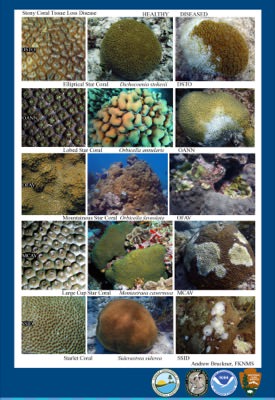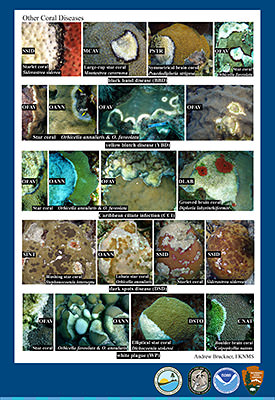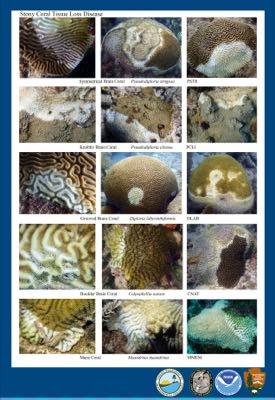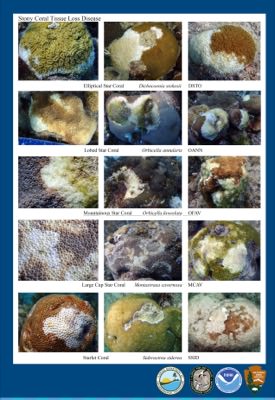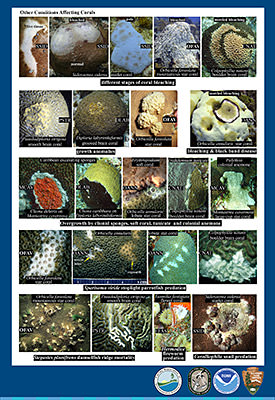Florida's Coral Reef Disease Outbreak: Disease
Investigation is ongoing to identify the cause of the stony coral tissue loss disease that is affecting nearly half of the stony coral species found on Florida's Coral Reef, including the primary reef-building species. Degree of susceptibility, signs of disease, rates of progression and mortality vary among coral species, locations and season.

Coral Disease Outbreak throughout the Caribbean
Stony Coral Tissue Loss Disease (SCTLD) Case Definition
This document compiles existing information on stony coral tissue loss disease and presents criteria to differentiate it from other coral diseases based on:
- Species susceptibility
- Diagnosis
- Transmission
- Prevalence
- Patterns of spread
- Rates of tissue loss
Note: This case definition is ever evolving and will be updated periodically. Scientific investigation continues into the cause and effect of the stony coral tissue loss disease and potential management and reef restoration strategies.
History
- Fall 2014 Isolated sites with significant coral disease were reported near Virginia Key (Miami-Dade County).
- Fall 2015 Widespread disease was confirmed as far north as Pompano Beach down to Biscayne National Park.
- Summer 2016 The disease continued to spread to Palm Beach County and to the Upper Florida Keys (Lower Matecumbe Key).
- Spring 2017 Reports of widespread disease were confirmed as far north as St. Lucie Inlet in Martin County and to the southern boundary of the Upper Florida Keys.
- Spring 2018 The disease expanded into the Lower Florida Keys and was suspected in Jamaica.
- Summer 2018 Signs of disease were reported in the Mexican Caribbean.
- Fall 2018 Disease corals were discovered in St. Maarten.
- Winter 2018-2019 The disease outbreak reached beyond Key West, and disease signs were reported in St. Thomas, USVI.
- Spring 2019 Disease observed in the Dominican Republic and Turks and Caicos.
- Summer 2019 Disease detected in Belize.
- Summer 2019 Disease discovered in St. Eustatius.
- Winter 2019-2020 Disease reported in St. John, USVI, Culebra, Puerto Rico, and Grand Bahama Island, Bahamas.
- Summer 2020 Disease detected in St. Croix, USVI, New Providence, Bahamas, Guadeloupe, and St. Lucia.
Affected Species
- Agaricia agaricites (Lettuce coral)
- Agaricia fragilis (Fragile saucer coral)
- Colpophyllia natans (Boulder brain coral)
- Dendrogyra cylindrus (Pillar coral)*
- Dichocoenia stokesii (Elliptical star coral)
- Diploria labyrinthiformis (Grooved brain coral)
- Eusmilia fastigiata (Smooth flower coral)
- Meandrina meandrites (Maze coral)
- Montastraea cavernosa (Great star coral)
- Madracis auretenra (Ten-ray star coral)
- Mycetophyllia spp. (Cactus coral)*
- Orbicella annularis (Lobed star coral)*
- Orbicella faveolata (Mountainous star coral)*
- Orbicella franksi (Boulder star coral)*
- Porites astreoides (Mustard hill coral)
- Porites porites (Clubtip Finger Coral)
- Pseudodiploria strigosa (Symmetrical brain coral)
- Pseudodiploria clivosa (Knobby brain coral)
- Siderastrea radians (Lesser starlet coral)
- Siderastrea siderea (Massive starlet coral)
- Solenastrea bournoni (Smooth star coral)
- Stephanocoenia intersepta (Blushing star coral)
* Listed under the U.S. Endangered Species Act
Signs of Disease
Tissue loss progresses as a band or line from the base of the colony to the margins or as a series of irregular blotches that radiate outward and often coalesce. Small colonies often die within a few weeks to months, while infections can persist on larger colonies for several seasons.
Corals are relatively simple animals that exhibit signs of stress through changes in pigmentation and loss of tissue. Because a coral consists of only three layers of tissue, it is often difficult to distinguish this tissue-loss disease from other diseases such as white plague. Disease signs can also vary among coral species and within individual corals, ranging from a distinctive white band to a series of irregular blotches that erupt across the colony surface and progressively increase in size.
Disease Identification Cards
These downloadable ID cards are provided to assist in properly determining if a coral colony is affected by stony coral tissue loss disease. Because this disease can resemble other coral diseases, it is important to distinguish for purposes of accurate reporting.
Hens and Chickens Reef
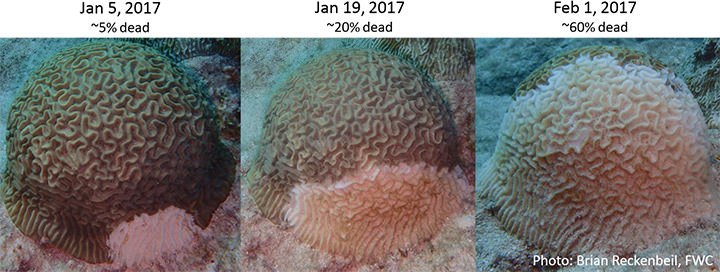
Watch a video from Florida Fish and Wildlife Research Institute showing a high prevalence of diseased brain corals on a small reef outcrop at Hen and Chickens Reef in Florida Keys National Marine Sanctuary.
Big Momma Collapse in Hollywood Florida
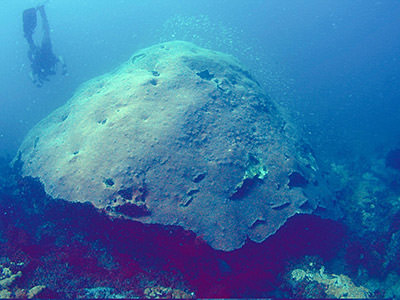
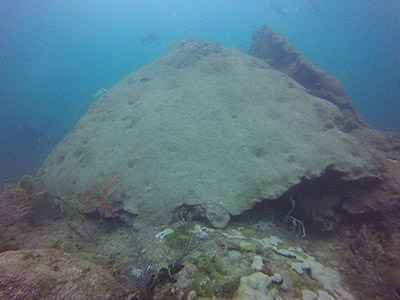
This "Big Momma" was the largest known colony of Mountainous Star coral (Orbicella faveolata) in Southeast Florida. At more than 330 years old, it was older than the United States. It survived the industrial revolution, numerous hurricanes, and the many stressors associated with the rapid urbanization. "Big Momma" died in a matter of three to four months after contracting this tissue-loss disease.



